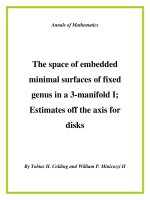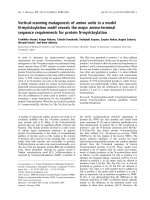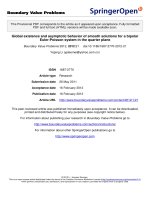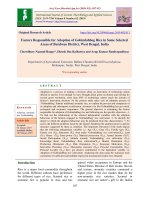Physico-chemical characteristics of Nalban wetland of east Kolkata wetlands, a Ramsar site, West Bengal, India
Bạn đang xem bản rút gọn của tài liệu. Xem và tải ngay bản đầy đủ của tài liệu tại đây (550.75 KB, 12 trang )
Int.J.Curr.Microbiol.App.Sci (2019) 8(4): 1264-1275
International Journal of Current Microbiology and Applied Sciences
ISSN: 2319-7706 Volume 8 Number 04 (2019)
Journal homepage:
Original Research Article
/>
Physico-Chemical Characteristics of Nalban Wetland of East Kolkata
Wetlands, A Ramsar Site, West Bengal, India
Ranga Ram Mohan1*, T.S. Nagesh2, Anish Das2, Sandeep Sahu2,
D. Ravindra Kumar Reddy1 and Anand Prasad Paturi1
1
2
College of Fishery Science, Muthukur, Nellore dt., Andhra Pradesh, India
Faculty of Fishery Sciences, Chakgaria, WBUAFS, Kolkata, West Bengal, India
*Corresponding author
ABSTRACT
Keywords
East Kolkata,
Nalban wetland,
Water quality, Soil
quality, Tolerable
limits, Ecological
integrity, Threats
Article Info
Accepted:
10 March 2019
Available Online:
10 April 2019
The important physico-chemical parameters of water such as temperature, pH, dissolved
oxygen, free carbon dioxide, total alkalinity, total dissolved solids, electrical conductivity,
Biological oxygen demand, nitrate-nitrogen, ammonia-nitrogen, phosphate-phosphorous
and soil quality parameters such as pH and organic carbon were studied in Nalban wetland
in triplicate by standard methods. Two-way analysis of variance (ANOVA) was performed
to test the significant differences, if any, in the mean values of physcio-chemical
parameters of water and sediment among months and sampling sites after confirmation of
normality and homogeneity of variance (Zar, 1999). Tukey (HSD) test (Tukey, 1977) was
used to evaluate pair-wise multiple comparisons. The difference was considered
statistically significant at P ≤ 0.05. All statistical analyses were performed using IBM
SPSS 20.0 statistical software. All physico-chemical parameters were found to be within
the tolerable limits of fishes that inhabit the wetland.
Introduction
Wetlands have been identified as one of the
key life supporting ecosystems on this planet.
They are considered as the most productive
ecosystems as they constitute huge floral as
well as faunal diversities (Chase, 2007). They
also play a very important role in socioeconomic condition of the concerned region
as they are used for aquaculture activities at
commercial level (Williams, 1990), crucial
for biodiversity conservation (Panthi et al.,
2014) and maintain the ecological integrity.
Kolkata is sustained by this unique and
friendly water regime which is in totality
named as East Kolkata Wetlands (EKW)
(Latitude 22˚33' - 22˚40'N; Longitude 88˚25' 88˚35'E). East Kolkata Wetlands was declared
as Ramsar site on 19th August 2002 by
Ramsar Convention Bureau. Wetlands
provide an environment where photosynthesis
can occur and the recycling of nutrients can
take place apart from playing a significant
role in supporting food chains (Adams, 1988).
1264
Int.J.Curr.Microbiol.App.Sci (2019) 8(4): 1264-1275
Within a wetland, the environmental
characteristics are determined mostly by
hydrological processes which display diurnal,
seasonal and even annual fluctuations in
response to meteorological, socioeconomic
and geographical factors (Mould et al., 2010).
Therefore the present study was carried out to
determine physico-chemical characteristics of
selected wetland.
Materials and Methods
Site selection
The sampling station called Nalban wetland
(Latitude
22°34'3.36"N;
Longitude
88°25'41.02"E) has been selected to analyse
physico-chemical parameters
Statistical analysis
Two-way analysis of variance (ANOVA) was
performed to test the significant differences, if
any, in the mean values of physico-chemical
parameters of water and sediment among
months and sampling sites after confirmation
of normality and homogeneity of variance
(Zar, 1999). Tukey (HSD) test (Tukey, 1977)
was used to evaluate pair-wise multiple
comparisons.
The difference was considered statistically
significant at P ≤ 0.05. All statistical analyses
were performed using IBM SPSS 20.0
statistical software.
Results and Discussion
Study Period
Water temperature (0°C)
The study was carried out for a period of six
months (September 2016 to February 2017)
for analysis of physico-chemical parameters
of water and sediment.
Collection of data
In the present study, an overall minimum and
maximum water temperature were observed
between 21.10±0.10 (site 1 and 2) in the
month of December and 31.10±0.10 (site 2) in
the month of September, respectively (Table
2).
Water and sediment samples were collected
on site the Nalban wetland in three different
sites viz., site 1(outlet), site 2 (middle) and
site 3 (inlet) on monthly basis between
morning 7.30 A.M. and 9.00 A.M. on
sampling day.
This range of water temperature was found
satisfactory and also ascertained by several
workers (Ayyappan, 2006, Dampin et al.,
2012; Mandal et al,. 2010; Jena and Das,
2011;) in sewage fed fish ponds in East
Kolkata wetlands and different areas in India.
Analysis of physico-chemical parameters of
water
Transparency (cm)
The physico-chemical parameters of water
such as temperature, transparency, pH,
dissolved oxygen, free carbon dioxide,
alkalinity, hardness, total dissolved solids,
electrical conductivity, biological oxygen
demand, nitrate-nitrogen, ammonia and
phosphorus were estimated in triplicate by
standard methods as described below.
In the present investigation it was revealed
that the minimum and maximum transparency
values varied from 19.10±0.17 in the month
of February to 28.47±0.15 cm in the month of
September (Table 3) and these results are
within ranged and strongly evident from work
done by Basu et al., (2013) on same water
body transparency, who reported transparency
value ranging between 8.0 - 54.2 cm.
1265
Int.J.Curr.Microbiol.App.Sci (2019) 8(4): 1264-1275
Water pH
Total alkalinity (mg/l)
The range of water pH observed in present
study generally remained within the range
observed by Nwabueze (2013); Mandal et al.,
(2010); Dasgupta et al., (2008); Santra and
Deb (1996) in different sewage fed ponds in
West Bengal. The present pH results
corroborated results (7.1 to 8.0) (Table 4)
reported by Sondhia (2008) in Nalban
wetland.
Alkalinity levels recorded in the present
study, thus, seem to be conducive for fish
growth. Mandal et al., (2010) observed the
range of total alkalinity from 122.8 to 167.2
mg/l in water sample of sewage fed fish pond.
Dampin et al., (2012) recorded the total
alkalinity of 121±19.16 mg/l in sewage fed
tilapia fish pond in Thailand. The total
alkalinity from 149 to 240 mg/l was observed
in Kolkata sewage fed fish pond by
Mukherjee (2011) which is in the similar
range recorded in the present study (Table 7).
Dissolved oxygen (mg/l)
The dissolved oxygen levels of Nalban
wetland showed minimum (7.28±0.04) in the
month of November and maximum
(8.52±0.10) during the month of January
(Table 5). The present results are within the
tolerable limits of fishes and the range
recorded by different workers in East Kolkata
Wetlands. Dasgupta et al., (2008) recorded
dissolved oxygen varying from 5.2 to 10.2
mg/l in sewage fed fish pond. The dissolved
oxygen level of wastewater fish pond was
9.6±3.4 as recorded by Dampin et al., (2012)
in Thailand. The fluctuation of dissolved
oxygen within the level of 5.6 to 12.4 mg/l in
sewage fed fish pond in Kolkata had been
reported by Santra and Deb (1996).
Free carbon dioxide (mg/l)
The present results indicated that free carbon
dioxide fluctuated from 8.20±0.10 to
16.30±0.10 mg/l in site 1 and 8.27±0.12 to
17.20±0.10 mg/l in site 2 and 8.83±0.15 to
16.43±0.15 mg/l in site 3 (Table 6).
Bhatnagar et al., (2004) suggested 5-8 mg/l is
essential for photosynthetic activity; 12-15
mg/l is sub lethal to fish and 50-60 mg/l is
lethal to fish. However, Boyd and
Lichtkoppler (1979) was of the opinion that
fish can survive up to 60 mg/l free carbon
dioxide concentration.
Total hardness (mg/l)
During the present investigation total
hardness levels were found to be in the range
of 249.33±4.04 mg/l in the month of
September to 296.33±4.04 mg/l in the month
of February (Table 8).
Thus, it appears that hardness is slightly
higher than the optimum levels. In treated
waste water, hardness varied from 560 mg/l to
770 mg/l (Chattopadhyay, 2002). Similar
results have been observed by Mukharjee
(2011) and Dampin et al., (2012) in the range
of 171±38.77 mg/l and 166 to 256 mg/l
respectively in sewage fed fish ponds in
Kolkata.
Total dissolved solids (mg/l)
The total dissolved solids of Nalban sewage
fed pond ranged from 341.00±6.00 mg/l to
463.67±6.66 mg/l during the study period
(Table 9). Dampin et al., (2012) recorded the
total suspended solid value of 68.65±21.39
mg/l in sewage fed tilapia fish pond in
Thailand. Mukharjee (2011) reported total
suspended solids and total dissolved solids in
the range between 52 to 107 mg/l and 327 to
589 mg/l, respectively, which is corroborated
with the present study.
1266
Int.J.Curr.Microbiol.App.Sci (2019) 8(4): 1264-1275
Electrical conductivity (μs/Cm)
The electrical conductivity of Nalban sewage
fed water body was ranging between
1076.00±9.85 μs/Cm (minimum in the month
of November) and1267.33±4.04 μs/Cm
(maximum in the month of December) during
study period (Table 10). This might be due to
heavy discharge of sewage in the month of
December. These results are in comparable
with results were observed by various
workers (Datta and Bhagwati, 2007; Hulyal
and Kaliwal, 2011; Ramulu and Benarjee,
2013).
Biological Oxygen Demand (BOD)
During the present investigation the BOD
level was found to be minimum (16.87±1.67
mg/l) in the month of September, while the
maximum concentration (33.17±1.04 mg/l)
was seen in the month of January (Table 11).
Thang and Yen (2003) recorded similar
pattern of variation in sewage fed fish ponds
in Vietnam. Due to the highly discharging of
organic loaded sewage and high microbial
activity BOD level in the water body was
elevated. Tanner et al., (1995) also stated that
the higher values of BOD during rainy season
was due to input of organic wastes and
enhanced bacterial activity.
Nitrate-Nitrogen (mg/l)
The nitrate-nitrogen recorded in Nalban
sewage wetland was very low and ranged
between 0.053±0.008 mg/l (minimum) to
0.145±0.041 mg/l (maximum) (Table 12).
The minimum value observed in the month of
January and the maximum value observed
during December month. Such low levels of
nitrate-nitrogen ranging between 0.05 and 2.2
mg/l was also recorded in the sewage fed
aquaculture system by Ghosh et al., (1974).
Ammonia-Nitrogen
The ammonium-nitrogen was generally
ranging from 0.29±0.02 mg/l to 0.52±0.06
mg/l (Table 13) during the study period. In
site wise variation, site 3 showed significant
(p<0.05) difference with the site 1 and site 2.
In monthly variation September and February
months
showed
significant
(p<0.05)
difference in between them and also with rest
of months.
Table.1 Standard methods
Parameter
Temperature (0°C )
Transparency (cm)
pH
Dissolved oxygen (DO) (mg/lit)
Free carbon dioxide (mg/lit)
Total alkalinity (mg/lit)
Total hardness (mg/lit)
Total dissolved solids (TDS)
Electrical conductivity (μs/Cm)
Biological oxygen demand (BOD) (mg/lit)
Nitrate-nitrogen (NO3-N) (mg/lit)
Ammonia-nitrogen (NH3-N) (mg/lit)
Phosphate-phosphorous (PO4-P) (mg/lit)
Soil pH
Soil organic carbon (%)
Instrument/method followed
Centigrade thermometer (Range: 0°C to 50°C)
Secchi disc (20 cm diameter)
Digital pH meter (Hanna, Portugal)
Azide modification method (APHA, 1998)
Titrating method (APHA, 1995)
Titration method (APHA, 1998
Titrating method (APHA, 1995)
TDS meter (HiMedia)
Digital conductivity meter (Make: Systronics, Model: 306)
APHA (1998) method
EPA approved Brucine Method (Bain, 2009)
Phenate method (APHA, 1998).
Stannous chloride method (APHA, 1998).
pH meter (Make: Systronics, Model: MK-VI)
Walkley-Black chromic acid wet oxidation method
1267
Int.J.Curr.Microbiol.App.Sci (2019) 8(4): 1264-1275
Table.2 Monthly variation (Mean ± SD) in water temperature (°C) in different sites of Nalban wetland during the study period
Month
SEPTEMBER
OCTOBER
NOVEMBER
DECEMBER
JANUARY
FEBRUARY
31.07±0.06e1
31.10±0.10b1
31.00±0.00d1
28.33±0.06c1
28.47±0.06b2
28.23±0.06c1
29.10±0.10d2
28.70±0.10b1
28.83±0.06c1
21.13±0.15a1
21.07±0.12a1
21.10±0.10a1
21.07±0.12a1
21.07±0.12a1
21.90±1.13a1
23.00±0.10b1
23.17±0.15b1
23.03±0.06b1
Site
Site 1
Site 2
Site 3
Values with the same superscripts do not differ significantly (P > 0.05).
Table.3 Monthly variation (Mean ± SD) in water transparency (cm) in different sites of Nalban wetland during the study period
Month
SEPTEMBER
OCTOBER
NOVEMBER
DECEMBER
JANUARY
FEBRUARY
26.80±0.10b1
27.07±0.12a2
28.47±0.15e3
26.07±0.12c2
24.93±0.12b1
25.23±0.25bd1
25.53±0.15d1
25.37±0.15c12
25.17±0.15d1
22.50±0.10e1
23.03±0.15d2
23.23±0.21c2
20.07±0.12a1
20.67±0.12e2
21.13±0.15a3
19.97±0.15a2
19.10±0.17f1
22.07±0.12b3
Site
Site 1
Site 2
Site 3
Values with the same superscripts do not differ significantly (P > 0.05).
Table.4 Monthly variation (Mean ± SD) in water pH in different sites of Nalban wetland during the study period
Month
SEPTEMBER
OCTOBER
NOVEMBER
DECEMBER
JANUARY
FEBRUARY
7.50±0.00c2
7.60±0.00b1
7.60±0.00bc1
7.43±0.06bc1
7.57±0.06b2
7.53±0.06ab12
7.40±0.00b1
7.50±0.00a2
7.57±0.06ab3
7.27±0.06a1
7.47±0.06a2
7.53±0.06ab2
7.63±0.06d1
7.80±0.00c2
7.67±0.06c1
7.37±0.06b1
7.60±0.00b3
7.50±0.00a2
Site
Site 1
Site 2
Site 3
Values with the same superscripts do not differ significantly (P > 0.05).
1268
Int.J.Curr.Microbiol.App.Sci (2019) 8(4): 1264-1275
Table.5 Monthly variation (Mean ± SD) in dissolved oxygen (mg/l) in different sites of Nalban wetland during the study period
Month
SEPTEMBER
OCTOBER
NOVEMBER
DECEMBER
JANUARY
FEBRUARY
7.33±0.15a1
7.43±0.15a1
7.60±0.20b1
7.50±0.10a1
7.36±0.06a1
7.37±0.12a1
7.77±0.11b2
7.61±0.08b2
7.28±0.04a1
8.32±0.08c1
8.23±0.10c1
8.27±0.11c1
8.52±0.10d2
8.280.04c1
8.38±0.07c12
8.17±0.05c1
8.480.11d2
8.25±0.07c1
Site
Site 1
Site 2
Site 3
Values with the same superscripts do not differ significantly (P > 0.05).
Table.6 Monthly variation (Mean ± SD) in free carbon dioxide (mg/l) in different sites of Nalban wetland during the study period
Month
SEPTEMBER
OCTOBER
NOVEMBER
DECEMBER
JANUARY
FEBRUARY
16.30±0.10d1
17.20±0.10c2
16.43±0.15b1
12.63±0.06c1
13.27±0.06d2
14.47±0.12c3
9.23±0.15b1
10.20±0.35e2
11.57±0.06d3
8.23±0.06a1
8.70±0.10d2
9.03±0.06a3
8.20±0.10a1
8.53±0.12ab2
9.00±0.10a3
8.60±0.00e1
8.27±0.12a2
8.83±0.15a3
Site
Site 1
Site 2
Site 3
Values with the same superscripts do not differ significantly (P > 0.05).
Table.7 Monthly variation (Mean ± SD) in total alkalinity (mg/l) in different sites of Nalban wetland during the study period
Month
SEPTEMBER
OCTOBER
NOVEMBER
DECEMBER
JANUARY
FEBRUARY
137.81±4.54a1
138.30±3.80b1
144.96±7.43b1
138.51±4.10a2
125.13±4.05c1
129.63±4.10c1
153.97±5.48b1
150.83±4.66d1
111.07±2.27d2
153.07±2.93b1
163.60±4.90e2
160.00±3.96a12
185.63±4.01c2
186.30±2.88a2
166.03±3.21a1
181.87±2.40c2
185.70±2.25a2
162.70±1.30a1
Site
Site 1
Site 2
Site 3
Values with the same superscripts do not differ significantly (P > 0.05).
1269
Int.J.Curr.Microbiol.App.Sci (2019) 8(4): 1264-1275
Table.8 Monthly variation (Mean ± SD) in total hardness (mg/l) in different sites of Nalban wetland during the study period
Month
SEPTEMBER
OCTOBER
NOVEMBER
DECEMBER
JANUARY
FEBRUARY
Site 1
249.33±4.04a1
264.00±2.65b1
271.00±2.65c1
272.00±4.00c1
282.33±3.51d1
293.67±2.31e1
Site 2
256.00±2.00a2
268.67±1.15b2
274.00±3.00c1
274.67±3.51c12
283.67±3.51d1
294.67±3.21e1
Site 3
260.67±1.15a2
274.00±2.00b3
276.00±3.00b1
281.00±2.65c2
294.00±2.00d2
296.33±4.04d1
Site
Values with the same superscripts do not differ significantly (P > 0.05)
Table.9 Monthly variation (Mean ± SD) in total dissolved solids (mg/l) in different sites of Nalban wetland during the studyperiod
Month
SEPTEMBER
OCTOBER
NOVEMBER
DECEMBER
JANUARY
FEBRUARY
Site 1
Site 2
447.33±4.73a1
463.67±6.66e2
411.67±4.04b2
418.00±5.29d2
397.33±4.73c2
408.00±6.56d2
374.00±4.58d1
386.00±6.00c2
341.00±6.00e1
356.33±6.51a2
356.33±6.03f1
368.33±3.79b2
Site 3
402.33±4.51d3
382.67±8.02c1
366.00±8.72d1
354.33±3.06a3
367.00±7.55b2
386.33±5.13c3
Site
Values with the same superscripts do not differ significantly (P > 0.05)
Table.10 Monthly variation (Mean ± SD) in electrical conductivity (µs/cm) in different sites of Nalban wetland during the study
period
Month
SEPTEMBER
OCTOBER
NOVEMBER
DECEMBER
JANUARY
FEBRUARY
Site
1171.67±7.64a12
1155.00±5.00b1
1076.00±9.85c1
1239.00±3.61d1
1221.33±4.16e1
1206.67±4.04f1
Site 1
Site 2
1182.00±4.00a2
1198.67±7.02b2
1123.33±6.11c2
1267.33±4.04b2
1257.33±6.03e2
1237.33±5.69f2
Site 3
1164.67±4.51a1
1201.67±5.13c2
1177.00±7.00d3
1211.67±3.79cd3
1244.33±7.64e3
1218.67±7.02d3
Values with the same superscripts do not differ significantly (P > 0.05)
1270
Int.J.Curr.Microbiol.App.Sci (2019) 8(4): 1264-1275
Table.11 Monthly variation (Mean ± SD) in Biological Oxygen Demand (mg/l) in different sites of Nalban wetland during the study
period
Month
Site
Site 1
SEPTEMBER
OCTOBER
NOVEMBER
DECEMBER
JANUARY
FEBRUARY
16.87±1.67 a1
18.47±1.02 a1
21.83±1.76 b1
19.57±1.01 ab1
17.00±1.61 a1
18.50±1.50 a1
Site 2
21.77±1.32 b2
17.50±0.89 a1
25.27±0.95 c2
23.03±0.96 b2
27.23±0.87d2
29.17±1.04e2
Site 3
28.53±0.75a3
28.50±1.5a2
31.50±0.50b3
28.57±0.40a3
33.17±1.04c3
30.23±0.87ab2
Values with the same superscripts do not differ significantly (P > 0.05).
Table.12 Monthly variation (Mean ± SD) in nitrate-nitrogen (mg/l) in different sites of Nalban wetland during the study period
Month
SEPTEMBER
OCTOBER
NOVEMBER
DECEMBER
JANUARY
FEBRUARY
Site
Site 1
0.083±0.012bc1
0.092±0.005c1
0.070±0.003ab1
0.091±0.007c1
0.065±0.008a1
0.083±0.010bc2
Site 2
0.083±0.005cd1
0.073±0.004bc2
0.069±0.008d1
0.085±0.005d1
0.053±0.008a1
0.067±0.005b1
Site 3
0.114±0.014a2
0.082±0.004a3
0.078±0.003a1
0.145±0.041b2
0.083±0.005a2
0.087±0.006a2
Values with the same superscripts do not differ significantly (P > 0.05).
Table.13 Monthly variation (Mean ± SD) in ammonia-nitrogen (mg/l) in different sites of Nalban wetland during the study period
Month
SEPTEMBER
OCTOBER
NOVEMBER
DECEMBER
JANUARY
FEBRUARY
0.29±0.02a1
0.39±0.03ab2
0.29±0.03a1
0.41±0.02b1
0.37±0.08a1
0.35±0.04b1
0.36±0.03b1
0.45±0.04bcd2
0.32±0.03ab1
0.39±0.03b1
0.41±0.03abc1
0.41±0.02c1
0.48±0.03c2
0.48±0.02cd2
0.31±0.02ab1
0.52±0.06c2
0.51±0.03d12
0.43±0.03c1
Site
Site 1
Site 2
Site 3
Values with the same superscripts do not differ significantly (P > 0.05).
1271
Int.J.Curr.Microbiol.App.Sci (2019) 8(4): 1264-1275
Table.14 Monthly variation (Mean ± SD) in phosphate-phosphorous (mg/l) in different sites of Nalban wetland during the study
period
Month
Site
Site 1
SEPTEMBER
OCTOBER
NOVEMBER
DECEMBER
JANUARY
FEBRUARY
0.08±0.00 a1
0.15±0.02 c1
0.32±0.01 e1
0.11±0.01 b1
0.21±0.02 d1
0.08±0.01 a1
Site 2
0.11±0.01 a1
0.25±0.01 b2
0.36±0.01 c2
0.17±0.01 d2
0.31±0.02 e2
0.14±0.01 f1
Site 3
0.09±0.00 a2
0.20±0.01 a3
0.30±0.02 a1
0.13±0.02 a3
0.21±0.02 a1
0.102±0.50 a1
Values with the same superscripts do not differ significantly (P > 0.05).
Table.15 Monthly variation (Mean ± SD) in soil pH in different sites of Nalban wetland during the study period
Month
SEPTEMBER
OCTOBER
NOVEMBER
DECEMBER
JANUARY
FEBRUARY
Site
Site 1
7.70±0.10b1
8.17±0.12d1
7.90±0.10c1
7.73±0.12bc1
7.30±0.10a1
7.60±0.10b1
Site 2
7.63±0.15ab1
8.07±0.15d1
7.90±0.10cd1
7.77±0.15bc12
7.40±0.10a1
7.60±0.10ab1
Site 3
7.80±0.10ab1
8.17±0.12c1
7.90±0.10ab1
8.00±0.10bc2
7.70±0.10a2
7.83±0.12ab2
Values with the same superscripts do not differ significantly (P > 0.05)
Table.16 Monthly variation (Mean ± SD) in organic carbon in different sites of Nalban wetland during the study period
Month
Site
Site 1
SEPTEMBER
OCTOBER
NOVEMBER
DECEMBER
JANUARY
FEBRUARY
1.88±0.09a2
2.36±0.09c2
1.78±0.09a1
1.89±0.05a1
2.43±0.07c1
2.10±0.12b1
Site 2
1.65±0.12a1
1.97±0.17b1
1.78±0.10ab1
1.67±0.09a2
2.28±0.15c1
1.97±0.04d1
Site 3
1.83±0.04a2
2.46±0.09c2
1.85±0.06a1
2.12±0.13d3
2.48±0.09c1
2.35±0.06c2
Values with the same superscripts do not differ significantly (P > 0.05)
1272
Int.J.Curr.Microbiol.App.Sci (2019) 8(4): 1264-1275
Map.1 & 2 Map of West Bengal & Map of East Kolkata Wetland
Station : Nalban wetland
Total organic carbon
There was significant (p<0.05) difference
between all three sites. September, November
and December showed no significant (p>0.05)
difference in between them but October,
January and February months showed
significant (p<0.05) difference with above
mentioned months (Table 16). Siddique et al.,
(2012) stated that 6-8.4 % of organic matter
were found from (1-5) years aged ponds and
10.6-11.3 % and 12.9-13.4 % organic matter
were found from (6-10) years and above 10
years aged ponds respectively.
In conclusion, the present study suggests that
the important physico-chemical parameters of
water such as temperature, pH, dissolved
oxygen, free carbon dioxide, total alkalinity,
total dissolved solids, electrical conductivity,
Biological oxygen demand, nitrate-nitrogen,
ammonia-nitrogen, phosphate-phosphorous
and soil quality parameters such as pH and
organic carbon were studied in Nalban
wetland and they were found to be within the
tolerable limits of fishes that inhabit in the
wetland. In view of the growing threats like
uncontrolled siltation, unregulated discharge
of waste water, industrial effluents, surface
run-off and encroachment a holistic approach
is the need of the hour for sustainable
utilisation of this unique ecosystem.
Acknowledgement
The authors thankfully acknowledged the
support and facilities provided by Dean,
Faculty of Fishery Sciences, WBUAFS,
Kolkata-97.
1273
Int.J.Curr.Microbiol.App.Sci (2019) 8(4): 1264-1275
References
Adams, G. (1988). Wetlands of the prairies of
Canada. Wetlands of Canada, pp. 155198.
Al-jaboobi, M., El-ariqi, S., El Housni, A.,
Zouahri, A. and Bouksaim, M. (2013).
Assessment of the impact of wastewater
use on soil properties. Journal of
Materials and Environmental Science,
5(3): 747-752.
Ayyappan, S., Jena, J.K., Gopalakrishnan, A.
and Pandey, A.K. (2006). Hand book of
fisheries and aquaculture. published by
Directorate of Knowledge Management
in Agriculture, ICAR. pp. 591-622.
Basu, A., Sengupta, S., Dutta, S., Saha, A.,
Ghosh, P. and Roy, S., 2013. Studies on
macrobenthic organisms in relation to
water parameters at East Calcutta
Wetlands. Journal of Environmental
Biology, 34(7): 733-737.
Bhatnagar, A., Jana, S.N., Garg, S.K. Patra,
B.C., Singh, G. and Barman, U.K.
(2004).Water quality management in
aquaculture, In: Course Manual of
summer school on development of
sustainable aquaculture technology in
fresh and saline waters, CCS Haryana
Agricultural, Hisar (India), pp 203- 210.
Bhowmik, M. L., Jena, J.K. and Ayyappan, S.
(2011). Waste water aquaculture. In:
Hand book of fisheries and aquaculture,
published by Directorate of knowledge
management in agriculture, ICAR, New
Delhi, pp.449-468.
Boyd, C.E. and Lichtkoppler, F. (1979).
Water Quality Management in Fish
Ponds. Research and Development series,
22: 45-47.
Chase, J.M. (2007). Drought mediates the
importance of stochastic community
assembly. Proceedings of the National
Academy of Sciences, 104(44): 1743017434.
Chatterjee, N.R., Sahoo, D. and Chetri, C.
(2014). Study on the monthly variation in
hydro biological condition and its relation
to fish production of a sewage fed Bheri
system at suburban Kolkata. Journal of
Aquaculture Research and Development,
5(7:100279): 1-8.
Chattopadhyay, G. N., Saha, P. K., Ghosh, A.,
and Karmakar, H. C. (1988). A study on
optimum BOD levels for fish culture in
wastewater ponds. Biological Wastes, 25:
79- 83.
Dampin, N., Tarnchalanukit, W., Chunkao, K.
and Maleewong, M. (2012). Fish Growth
Model for Nile Tilapia (Oreochromis
niloticus) in Wastewater Oxidation Pond,
Thailand.
Procedia
Environmental
Sciences, 8: 513–524.
Dasgupta, S., Pandey, B.K., Sarangi, N. and
Mukhopadhyay P.K. (2008). Evaluation
of water productivity and fish yield in
sewage-fed vis-a`-vis fertilized based
carp culture. Bioresource Technology, 99:
3499-3505.
Ghosh, A., Maity, B., Chakrabarti, K. and
Chattopadhyay, D. (2007). Bacterial
diversity of east Calcutta wet land area:
possible identification of potential
bacterial
population
for
different
biotechnological
uses.
Microbial
Ecology, 54(3): 452-459.
Jena, J. and Das, P.C. (2011). Grow‐out
performance of Kuria labeo, Labeo
gonius (Hamilton), with major carps in
carp polyculture system. Aquaculture
Research, 42(9): 1332-1338.
Mandal, B., Some, S. and Banerjee, B.
(2010). Comparative studies on primary
productivity of sewage fed freshwater
fishpond in relation to production
efficiency
of
phytoplankton.
International Journal of science and
nature, 1(1): 89-94.
Meade, J.W. (1985). Allowable ammonia for
fish culture. Progressive Fish culture, 47:
135- 145.
Mould, D.J., Frahm, E., Salzmann, T.,
1274
Int.J.Curr.Microbiol.App.Sci (2019) 8(4): 1264-1275
Miegel, K. and Acreman, M.C. (2010).
Evaluating
the
use
of
diurnal
groundwater fluctuations for estimating
evapotranspiration
in
wetland
environments: case studies in southeast
England
and
northeast
Germany. Ecohydrology, 3(3): 294-305.
Mukherjee, D. P. (2011). Stress of urban
pollution on largest natural wetland
ecosystem in East Kolkata-causes,
consequences and improvement. Scholars
research library, Archives of Applied
Science Research, 3(6): 443-461.
Nwabueze,
A.
A.
(2013).
Growth
Performance of the Mudfish, Clarias
anguillaris (Pellegrin, 1923) in Treated
and Untreated Domestic Sewage,
Sustainable
Agriculture
Research.
Canadian Center of Science and
Education, 2(1): 62-69.
Panthi, S., Dhakal, M., Thagunna, S.S. and
Thapa, B.B. (2014). Status of Wetland in
Dhorpatan Hunting Reserve, Nepal. Open
Journal of Ecology, 4(05): 245.
Saha, K.C. and Majumdar, B. (1970).
Fisheries of West Bengal. Superintendent,
Government, Print., West Bengal
Government Press. 35(5): 216-217.
Santhosh, B. and Singh, N. P. (2007).
Guidelines for water quality management
for fish culture in Tripura, ICAR
Research Complex for NEH Region,
Tripura Center, Publication no.29.
Santra, S.C. and Deb, S.C. (1996).
Hydrochemistry and hydrobiology of
sewage fed jheels in the tropics: a case
study. Indian Hydrobiology, 1: 5–17.
Siddique, M.A.M., Barua, P. and Ghani, M.H.
(2012). Comparative study of physicochemical properties of soil according to
the age of aquaculture pond of
Bangladesh. Mesopotamian Journal of
Marine Science, 27(1): 29-38.
Sondhia, S. (2008). Evaluation of SewageFed Fisheries in Terms of water quality
Risk of Heavy metal contamination and
Fish Yield., Proceedings of Taal 2007:
The 12thWorld Lake Conference edited
by Sengupta, M. and Dalwani, R.,
pp.165-166.
Thang, V.Q. and Yen, M. D. (2003).
Wastewater-fed aquaculture in the
wetlands of Hanoi, status and problems.
Osaka University Knowledge Archieve,
Bulletin of Universities, Ministry of
Training and Education, pp. 60-66.
Williams,
M.
(1990).
Understanding
Wetlands In: Wetlands: A threatened
Landscape. Michael Williams, Basil
Blakewell Ltd., Oxford, pp. 1-3.
Zar, J. H. (1999). Biostatistical analysis.
Pearson Education India, 4th edition. pp.
3-10.
How to cite this article:
Ranga Ram Mohan, T.S. Nagesh, Anish Das, Sandeep Sahu, D. Ravindra Kumar Reddy and
Anand Prasad Paturi. 2019. Physico-Chemical Characteristics of Nalban Wetland of East
Kolkata Wetlands, A Ramsar Site, West Bengal, India. Int.J.Curr.Microbiol.App.Sci. 8(04):
1264-1275. doi: />
1275









